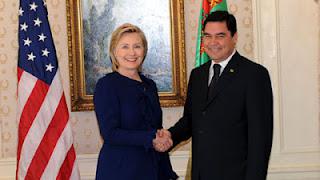 On Wednesday, at a meeting of the State Safety Council of Turkmenistan, the Turkmen president and commander in chief of the armed forces Gurbanguly Berdimuhamedov stated that the permanent neutrality status chosen by Ashgabat and recognized by the U.N. General Assembly in 1995 allows the country to realize its peacekeeping potential, making positive initiatives to resolve the urgent issues concerning all progressive mankind. “Peace lies at the basis of military doctrine, having an exclusively defensive character,” Berdimuhamedov said, adding that “the Turkmen government will continue to take all measures to ensure a high level of combat readiness of its Armed Forces”.
On Wednesday, at a meeting of the State Safety Council of Turkmenistan, the Turkmen president and commander in chief of the armed forces Gurbanguly Berdimuhamedov stated that the permanent neutrality status chosen by Ashgabat and recognized by the U.N. General Assembly in 1995 allows the country to realize its peacekeeping potential, making positive initiatives to resolve the urgent issues concerning all progressive mankind. “Peace lies at the basis of military doctrine, having an exclusively defensive character,” Berdimuhamedov said, adding that “the Turkmen government will continue to take all measures to ensure a high level of combat readiness of its Armed Forces”.
Turkmenistan became the first Central Asian state to join NATO’s Partnership for Peace (PfP) program in 1994, and Turkmen officers have indeed participated to several PfP exercises. In January 2011, Gen. James N. Mattis, Commander of the United States Central Command (CENTCOM), visited Turkmenistan and met with President Berdimuhamedov. Reportedly, the two sides discussed about Ashgabat’s possible role in the Northern Distribution Network (NDN), the rail, road and air network that ferries supplies across Central Asia to US and NATO troops in Afghanistan whose importance has increased considerably since the closure of the Pakistani-Afghan border to non-military freight in late 2011. Although Turkmenistan is not officially part of the NDN because of its neutrality status, all five Central Asian states in facts allow US military overflights over their territories, thereby cooperating to Washington’s was effort in Afghanistan.
As revealed by US diplomatic cables released last year by WikiLeaks, as of 2003 Turkmens and Americans have actually signed several secret agreements on the use of Turkmenistan’s airspace by US Air Force aircrafts engaged in the fight against the Taliban, thus making serious doubts arise about Ashgabat’s much-publicized position of neutrality. The US has gained access to use almost all the military airfields of the Central Asian country, including the airport in Nebit-Dag near the Iranian border, and the Mary-2 airfield, reconstructed by US military experts with the help of Arab construction companies. To preserve its formal neutrality facing the possible reactions of both Iran and Russia, the Turkmen establishment have tried to describe the facilities not as “military bases,” but “subsidiary support bases,” withouthoweverchangingthe substance.
But the geostrategic importance of Turkmenistan for the United States lies not only on the role played by the former Soviet republic in the was on terrorism, but first and foremost on its hydrocarbon wealth. Turkmenistan contains 1.4 billion barrels of proven oil reserves and nearly 100 trillion cubic feet of proven gas reserves, with some estimates suggesting this figure could be as high as 535 trillion cubic feet. The geopolitical location of the country, intersection between the Islamic world to the south, the Russo-Kazakh axis to the north, and Euro-Atlantic and Chinese pressure coming from west and east respectively, makes the US-Turkmen partnership critical for Washington’s plans to maintain its global dominance through control of Eurasia’s energy resources and transportation routes.
On its part, Turkmenistan is interested in diversifying its energy export routes, still mostly relying on Russian-controlled pipelines. Ashgabat is already providing China with its natural gas through the Central Asia–China gas pipeline and is actively involved in the discussions regarding both the Trans-Afghanistan and the Trans-Caspian pipelines projects. The Trans-Afghanistan Pipeline is a proposed natural gas pipeline designed to transport Caspian Sea gas from Turkmenistan through Afghanistan into Pakistan and then to India; hence its abbreviation in “TAPI,” from the first letters of the four countries. The Trans-Caspian Gas Pipeline is instead a proposed submarine pipeline between Türkmenbaşy in Turkmenistan, and Baku in Azerbaijan, whose construction would enormously increase the potential of the EU-backed Nabucco gas pipeline project.
THE TRANS-CASPIAN AND NABUCCO GAS PIPELINE PROJECTS

All these projects aim at reducing Russian dominance over Central Asia’s hydrocarbons resources and are part of the New Great Game for geostrategic control of the region. Although Russia seems to have acquired, through the progress of the South Stream project, an unbridgeable advantage over the Anglo-Americans in the pipelines war, American military presence in Europe, the Middle East and Central Asia makes still possible the establishment of a new US-led order in the former Soviet space, of which Turkmenistan is becoming an always more important actor.

